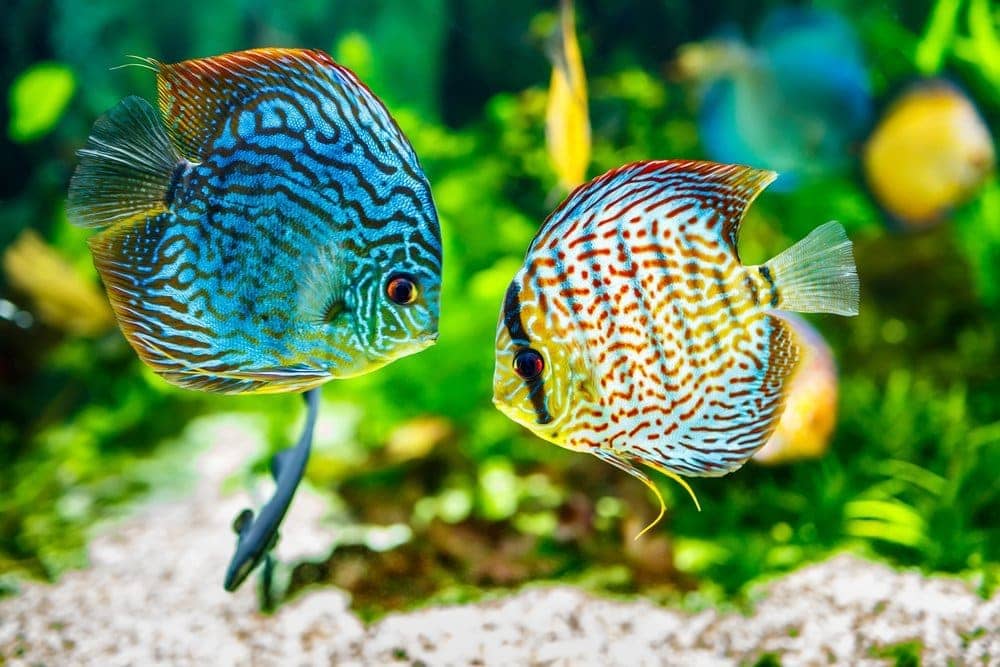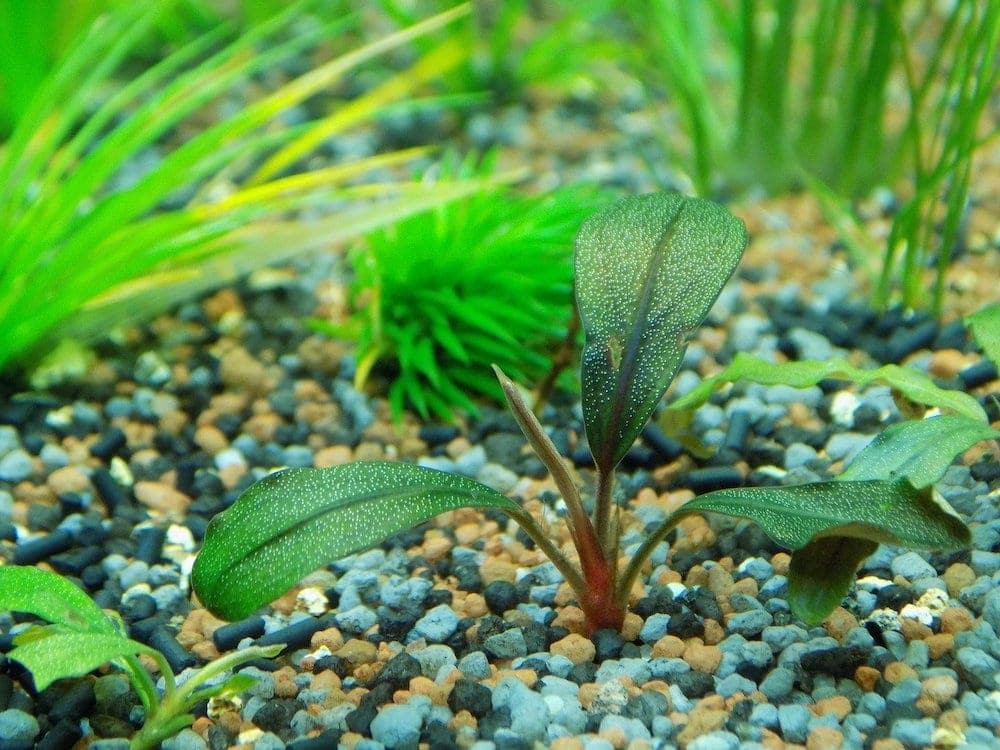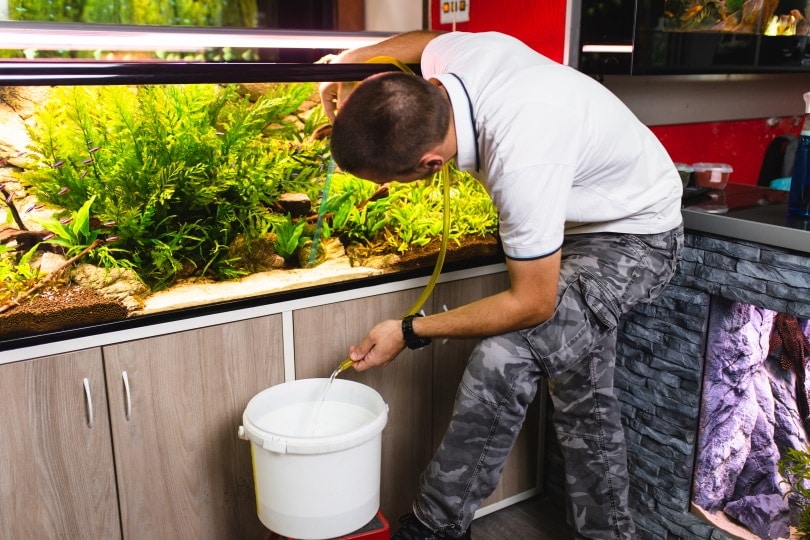30 Great Cold Water Fish for Your Aquarium: No Heater Needed
Updated on
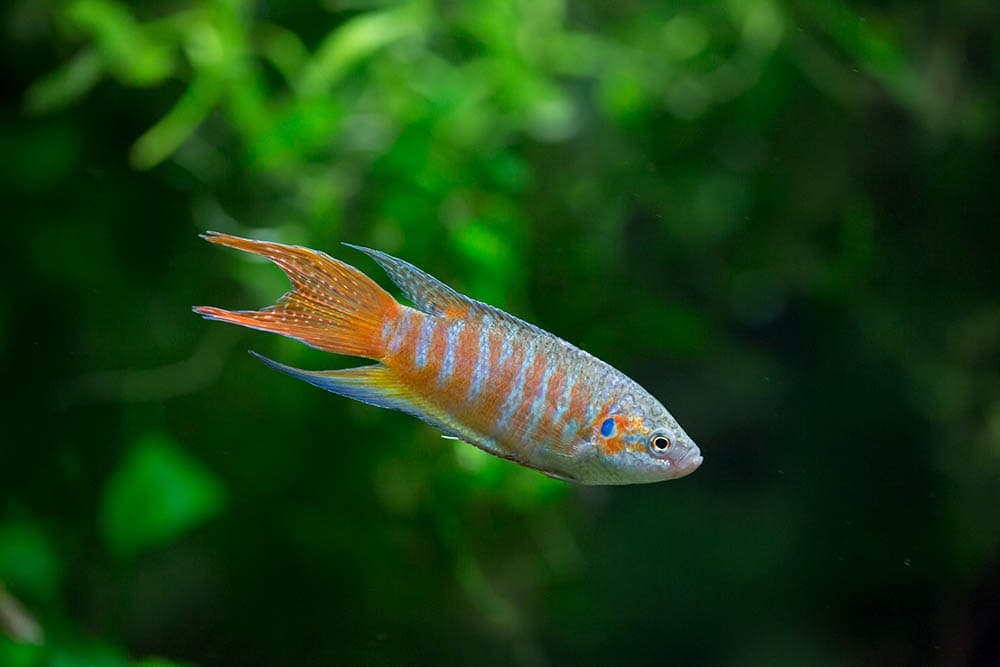
Keeping an aquarium can require a lot of electrical outlets to account for all the electronics, like filters, air pumps, lights, and heaters. If you’re running low on space and you’re looking for ways to save space, then keeping a cold water aquarium can give you the opportunity to do away with the necessity of a heater, opening up some outlet and tank space. Cold water fish are often hardy fish species, making them ideal for beginners who aren’t comfortable with keeping track of setting, monitoring, and maintaining an aquarium’s temperature.
Here are some of the best cold-water fish you can keep in your heater-free aquarium.
The 30 Cold Water Fish for Your Aquarium
1. Goldfish
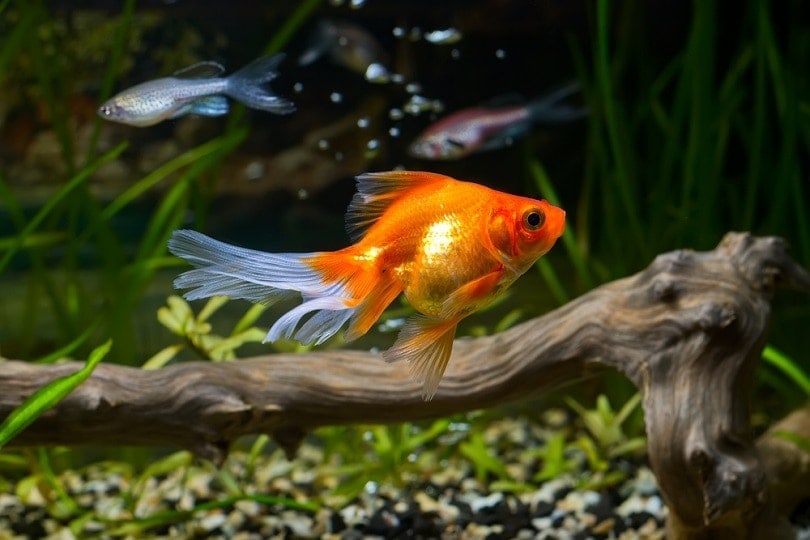
The most widely kept fish on the market is often overlooked for being too common and “boring,” but goldfish are exceptionally hardy fish that can thrive in cold and temperate waters. They can survive in water that is below freezing as long as there is a surface opening in the ice for oxygenation. They’re available in tons of shapes, sizes, and colors, and goldfish are social and intelligent fish, making them an exceptional addition to your tank. Goldfish are happiest in water that is 60–74˚F.
2. Dojo Loaches

Also known as Weather Loaches, these fish are highly social and quite friendly with their keepers, making them a fun aquatic pet to have. They are hardy fish that can tolerate poor water quality and a wide range of temperatures. They get quite large, though, and many people consider them to be large tank or pond fish. They prefer temperatures from 68–72˚F, although there are many reports of them surviving overwintering outdoors without heating. Dojos are an invasive species and illegal to own in some areas, so check out your local laws before attempting to purchase some.
3. White Cloud Mountain Minnows
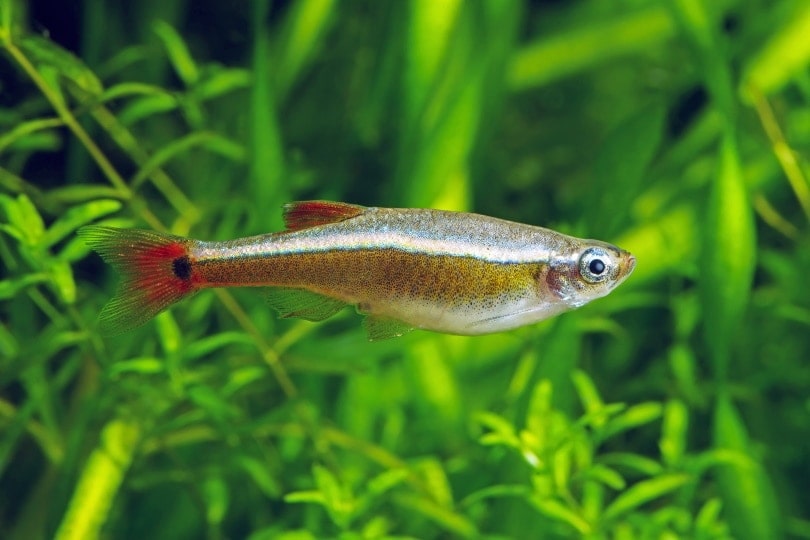
These shoaling fish aren’t just hardy, but they also have shimmery scales, bringing color and entertainment to your tank. White Cloud Mountain Minnows are often recommended as goldfish tank mates, especially for smaller goldfish, due to their similar water parameter needs and the peaceful nature of WCMM. Their preferred water temperature range is from 64–72˚F, but they are known to survive temperatures as low as 40˚F and can overwinter outdoors.
4. Rosy Red Minnows
Often sold as feeder fish, Rosy Red Minnows are underrated fish that exhibit complex social behaviors and bring flashes of rosy color to the tank. They are hardy and adaptable fish that thrive in temperatures from 50-78˚F. They are another good tank mate option for small goldfish and are peaceful fish, although males can be fiercely protective of their eggs and may be territorial when it comes to their selected dwelling.
5. Celestial Pearl Danios
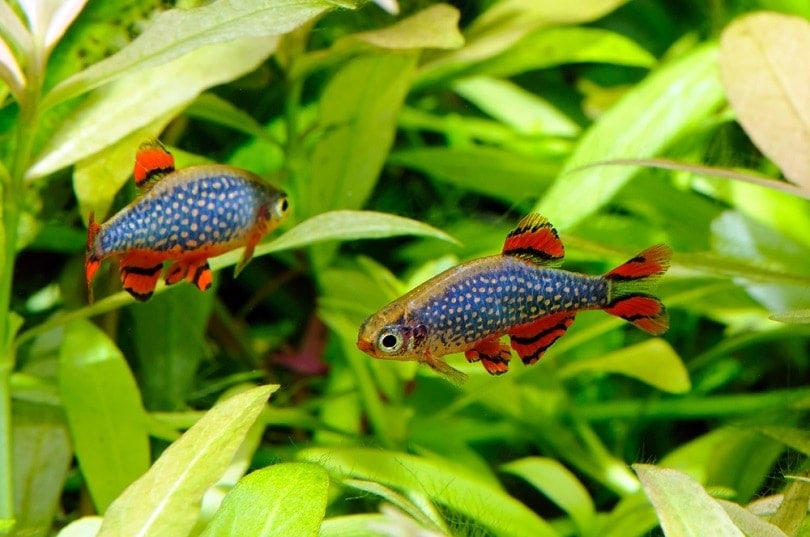
Having only been discovered around 2006, the Celestial Pearl Danio (CPD), or Galaxy Rasbora, are tiny fish with attractive colors and big personalities. They can be kept in water from around 70–80˚F and are a good option for nano and small tanks. They are peaceful but timid fish that make good tank mates with other peaceful fish, like Guppies and Tetras. Males will fight with each other over females, though, so it’s recommended to keep multiple females for every male. There have even been some reports of male CPDs killing all the other male CPDs in the tank.
6. Zebra Danios
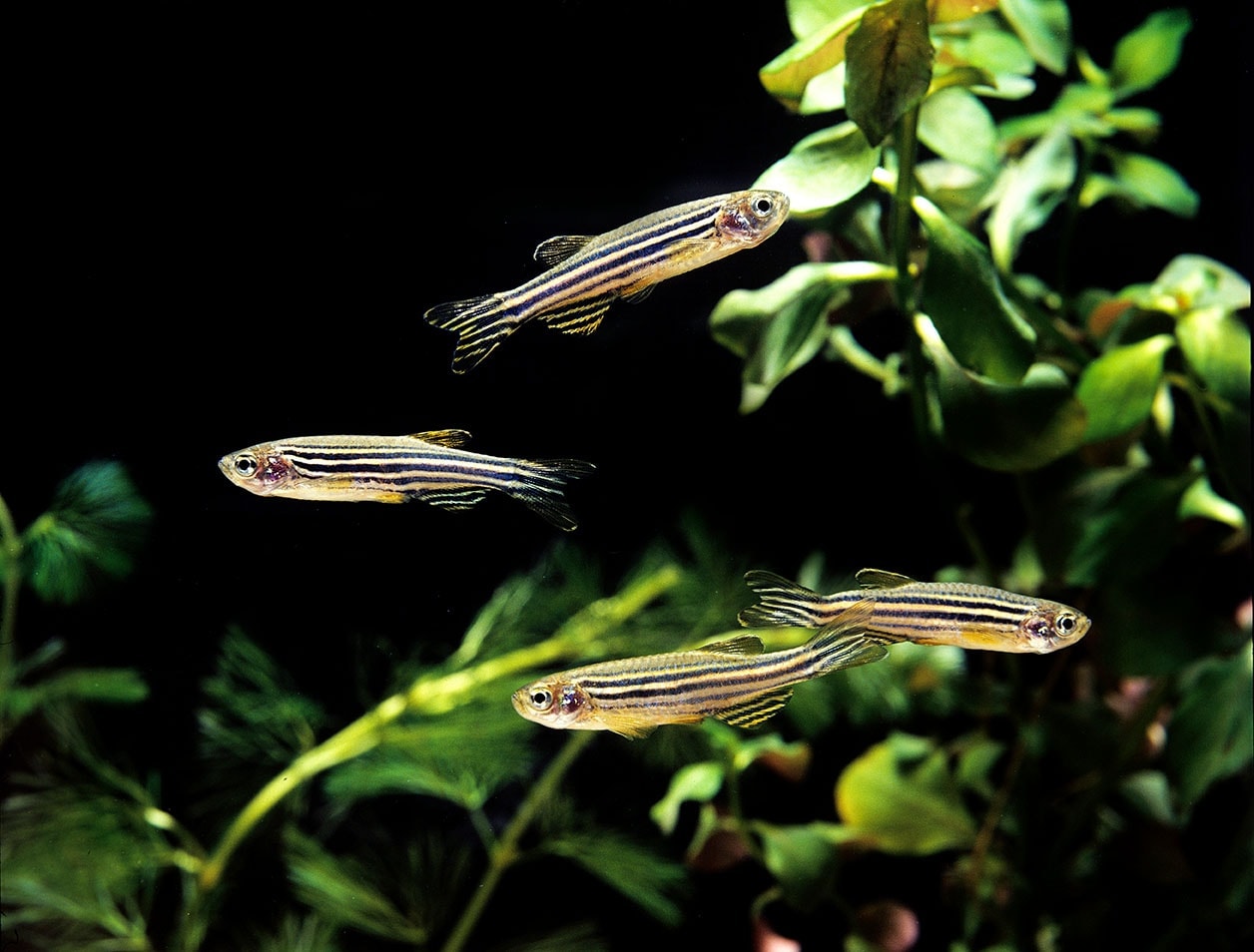
These hardy and popular fish thrive in temperatures from 64–78˚, but they are adaptable and can adjust to almost any freshwater tank environment. They are highly active fish that may be overwhelming for shy tank mates. They are playful and may nip at fins, so avoid keeping them with long-finned fish. They should be kept in shoals, and they will never cease to entertain you with their social behaviors. Zebra Danios mate for life, which is highly unusual in the fish world.
7. Leopard Danios
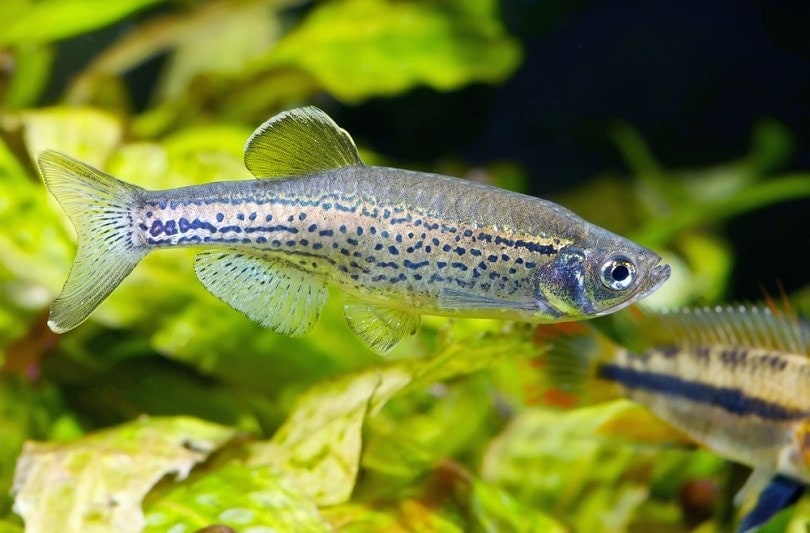
Like their Zebra cousins, Leopard Danios are hardy fish that thrive in temperatures from 64–80˚F, although they are adaptable. They have similar needs and social structures to Zebra Danios. They are active, playful fish that are overall peaceful but may be too energetic and curious for shy tank mates. Their adaptability does mean they are often appropriate for cold water, temperate, or tropical freshwater tank environments.
8. Giant Danios
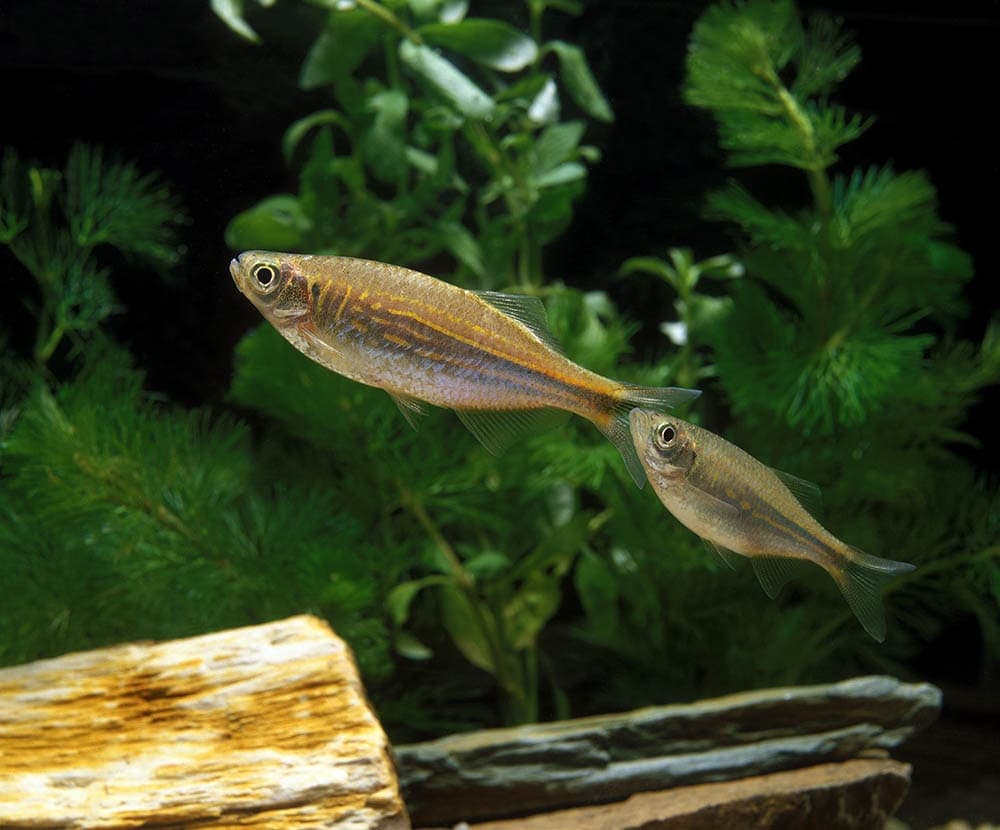
This large Danio can exceed 5 inches as an adult, making it larger than the other Danio species. These fish prefer water on the higher end of the cold water spectrum, with their lowest preferred temperature being around 70˚F, so they aren’t suited for all cold water tanks. They are beautiful fish that make a terrific addition to tanks with other larger cold-water fish, like goldfish and Dojo Loaches. They should be kept in shoals, so plan to keep Giant Danios in at least a 30-gallon tank.
9. Hillstream Loaches
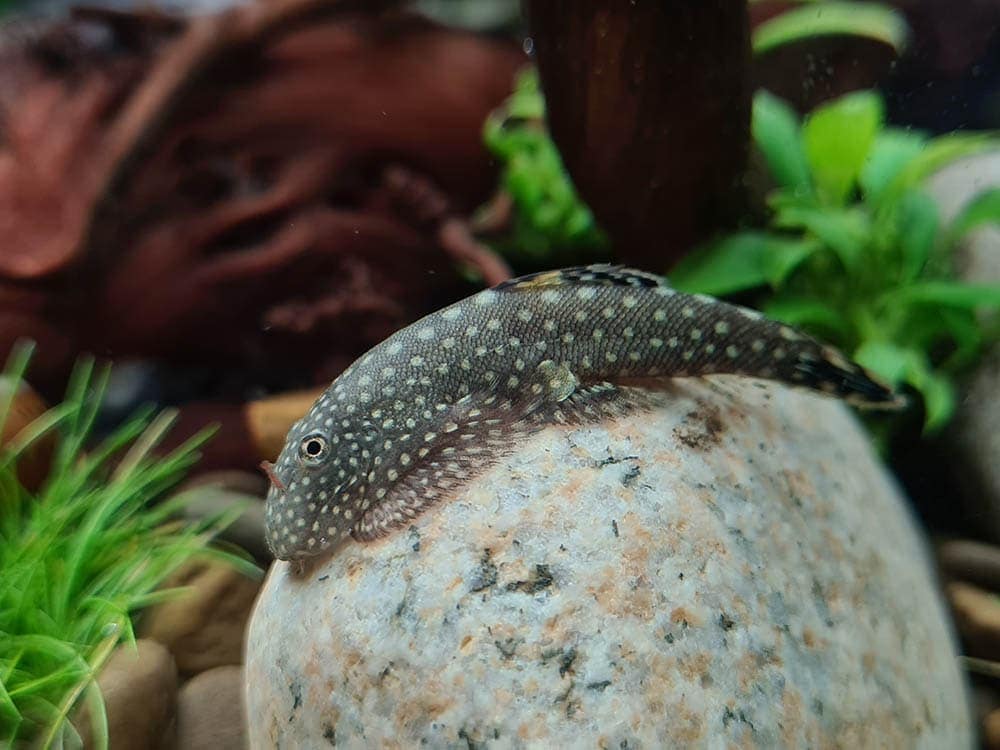
Hillstream Loaches are unusual fish that become less timid and more interesting to watch when kept in groups. They prefer water between 68–75˚F, and they require highly oxygenated water with fast-moving currents. They do require relatively large tanks due to their need for moving water, even though these fish only grow to around 3 inches in length. They also require high water quality, which means regular water changes, even in a large tank.
10. Panda Corydoras

The Panda Cory is a cute, black and white fish that prefers water between 65–80˚F, although it’s worth noting that captive-bred Panda Corys tend to prefer slightly warmer waters than wild-caught fish. These catfish prefer living in groups of their own kind, and they become quite active and entertaining in groups. If kept alone, they may be timid and blend into the background of the tank, so to speak.
11. Guppies
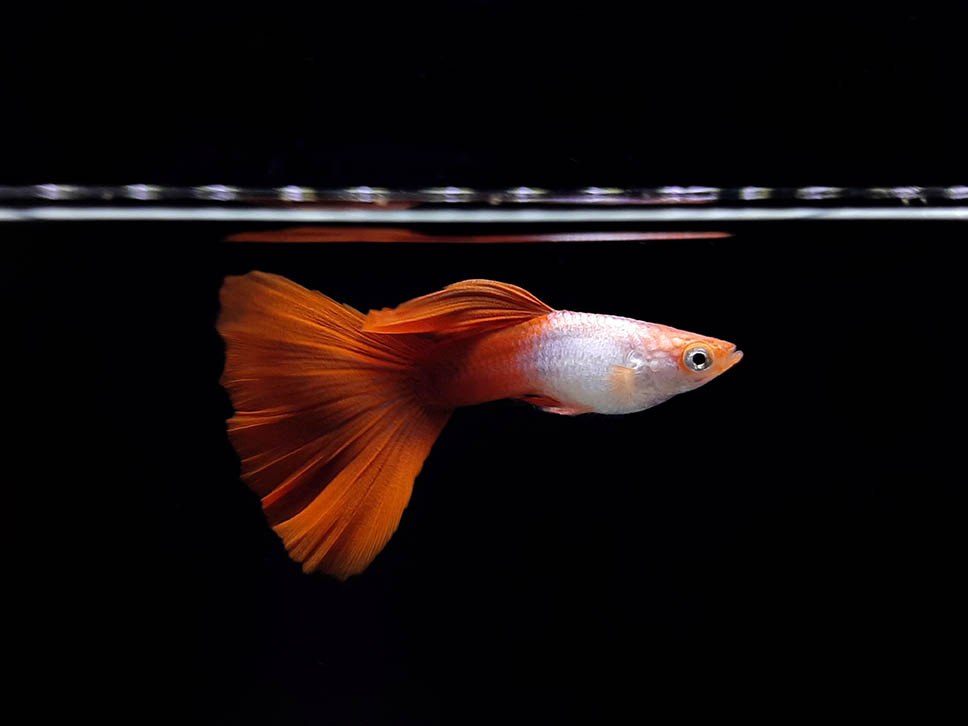
These colorful, prolific breeders are adaptable and can survive in water as cool as 60˚F, although they thrive in temperatures in the low to mid-70s. They are extremely active fish that will often swarm the glass when they see the person that feeds them enter the room. Unless you have the capacity to handle hundreds or thousands of Guppies, it’s best to keep them in single-sex tanks. If you choose to keep male and female Guppies together, make sure your females significantly outnumber the males as these fish prefer to be kept in harems, and males will compete for females.
12. Endler’s Livebearers
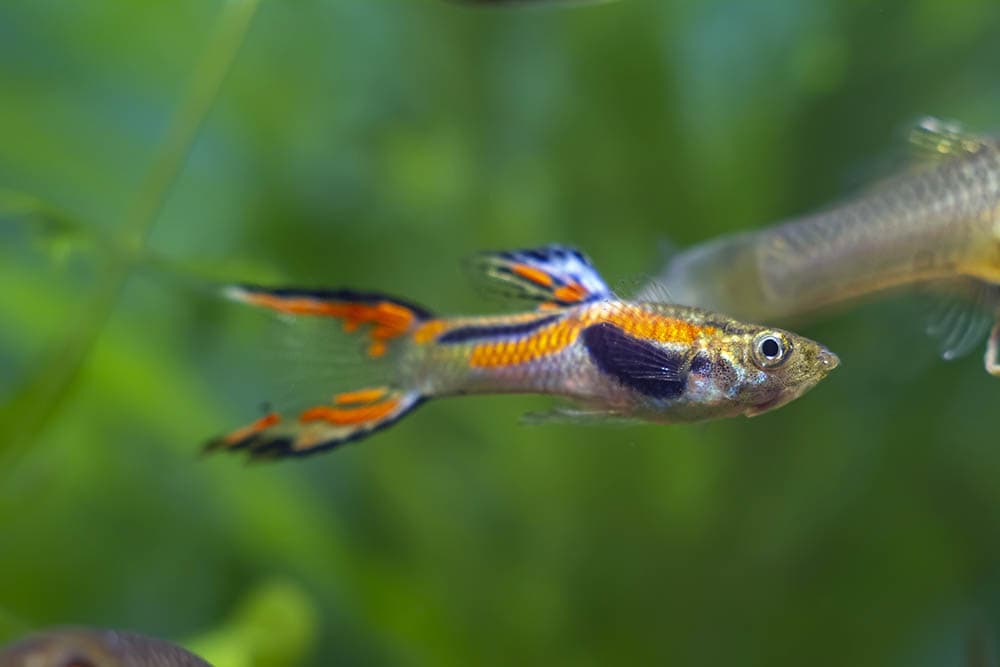
These small Guppy relatives are highly colorful and reproduce just as readily as Guppies. They prefer water at the warmer end of the cold water spectrum, with their lowest preferred temperature being between 72–74˚F. They are often sold as feeder fish, so acquiring Endler’s is often an easy task. Plan to keep single-sex tanks unless you’re prepared for tons of babies.
13. Sunset Platies
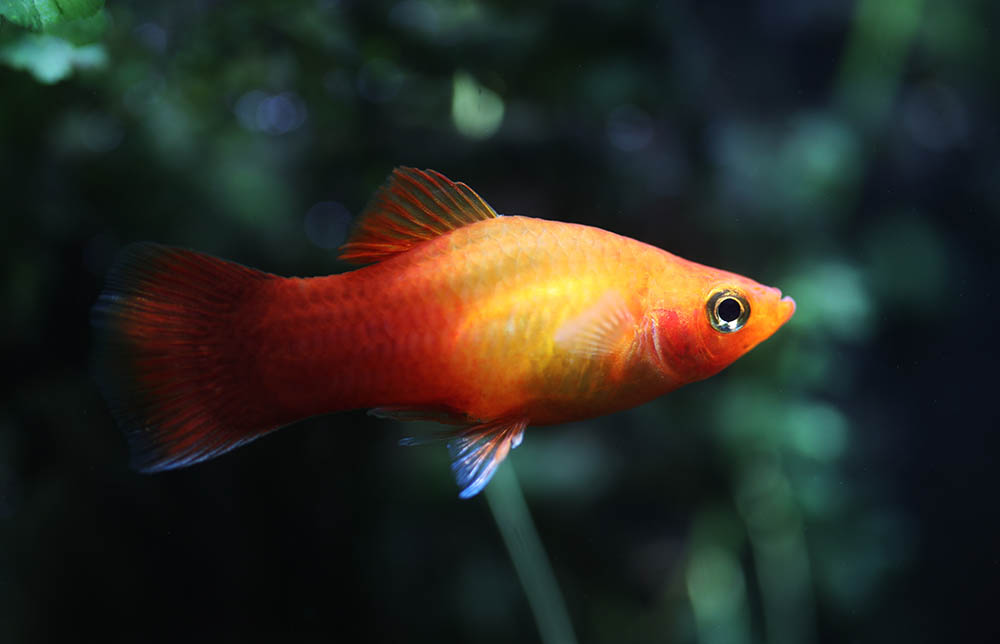
Sunset Platies are somewhere between bright orange and creamsicle in color with black accents. They do well in temperatures as cool as 68˚F and will survive in even cooler temperatures, although this may shorten their life expectancy. They are active, energetic fish that prefer to be kept with other Platies, although they are not true shoaling fish. They’re hardy enough for beginners and can be kept in tanks as small as 10 gallons.
14. Odessa Barbs
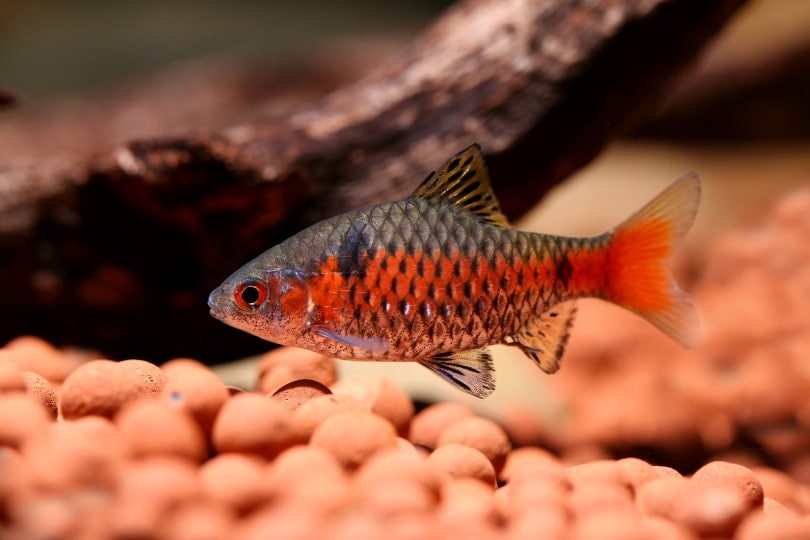
These eye-catching Barbs are tolerant of water temperatures as low as 65˚F, although they can be kept in temperate and low tropical temperatures as well. Their beautiful coloration is enhanced by a healthy tank environment, including plenty of plants. Oftentimes, males exhibit brighter coloration when there are other males to compete with for females. They are curious and active shoaling fish.
15. Rosy Barbs
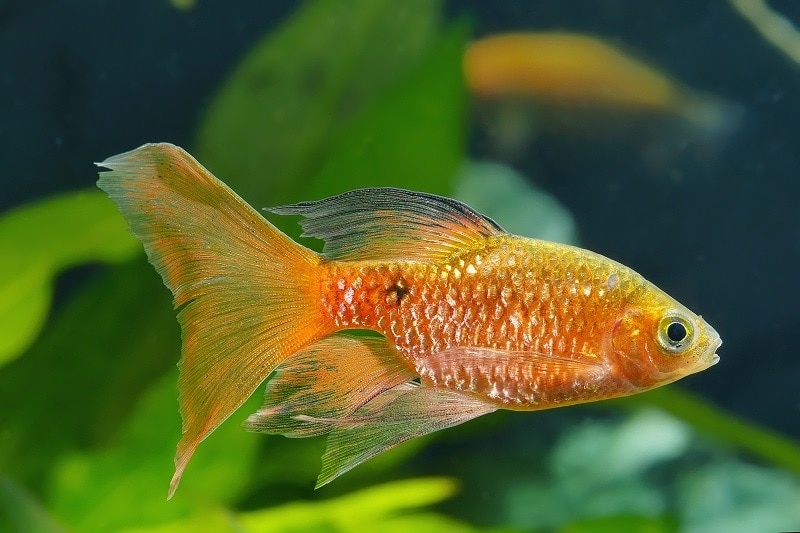
Rosy Barbs are shoaling fish that prefer water temperatures from 64–72˚F, although they are adaptable to warmer temperatures. Males are bright, rosy red, while females tend to have more of a silver or gold sheen. They are curious fish that are known for fin nipping, so avoid keeping them with timid fish. Their torpedo-shaped bodies make them agile swimmers, and they aren’t afraid to zip around the tank in search of food or entertainment.
16. Gold Barbs

Like Rosy Barbs, Gold Barbs prefer water temperatures between 64–72˚F. They are gold-colored shoaling fish that get slightly larger than most other Barb varieties, reaching around 3 inches in length. They are peaceful, especially when kept in the comfort of other Gold Barbs, although they will nip at the fins of long-finned fish. Males will often take on a brighter gold coloration when attempting to get the attention of females.
17. Neon Tetras
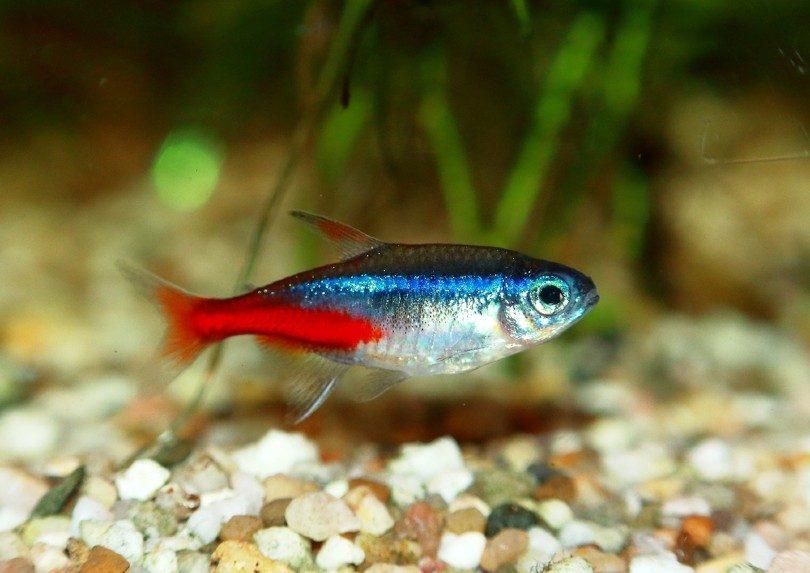
The most popular Tetra species on the market, the Neon Tetra is a cute, petite fish that lives in water temperatures between 68–82˚F. They should be kept in groups of at least six fish, although 10 or more fish is ideal to see the healthiest coloration and most active behaviors. They are good beginner fish, but they should not be confused with the similar-looking Cardinal Tetra, which is a less hardy fish.
18. Bloodfin Tetras
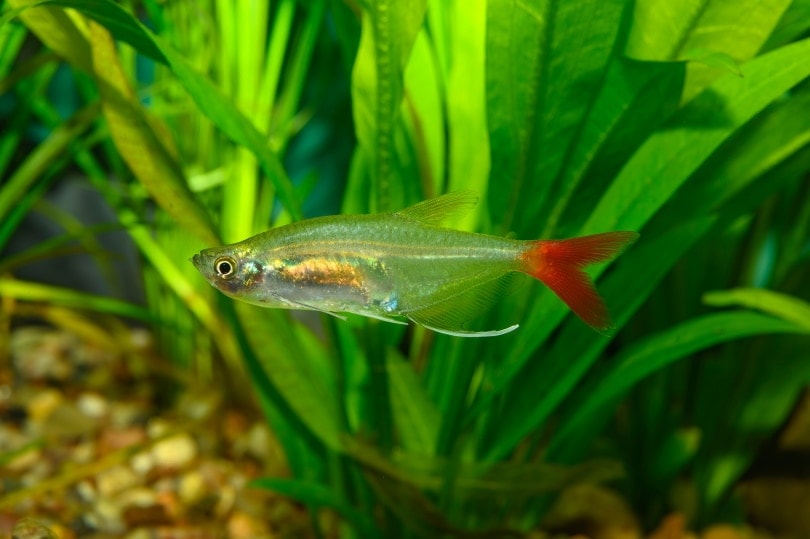
Bloodfin Tetras are a beautiful Tetra variety that you won’t come across every day. They can tolerate water temperatures from 64–82˚, but their preferred temperatures are in the low 70s. They stay relatively small, only growing to around 2 inches. They should be kept in groups of six or more fish to prevent aggressive or bullying behaviors, like fin nipping. They have silvery bodies with bright red on the fins, giving them their name.
19. Buenos Aires Tetras

This hardy Tetra can be kept in water temperatures from 65–82˚F and may do well in even cooler temperatures. They are large for a Tetra, reaching around 3 inches as adults. They have shimmery, metallic scales with red and black markings on the fins and body. They are peaceful enough for community tanks should be kept in shoals for comfort and to keep them healthy. They are unlikely to spawn in cold water environments, so plan to keep a separate spawning tank if you intend to breed them.
20. Mosquito Fish
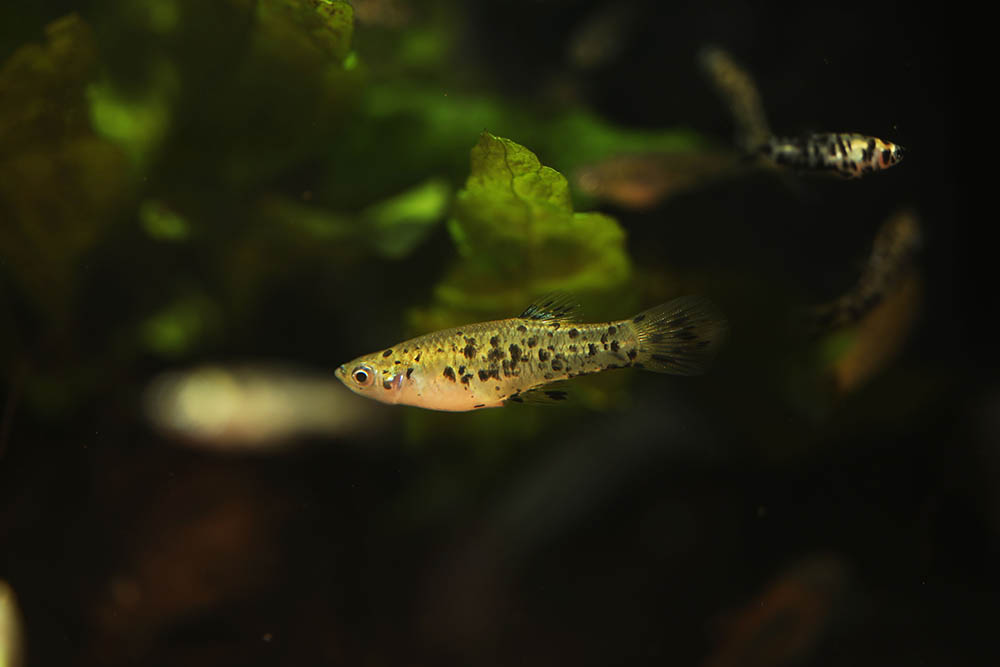
Mosquito fish are an excellent option for ponds that need mosquito control since they eat mosquito larvae. However, they can be great for indoor tanks as well. These fish can survive in about any setting, and while they prefer temperate water temperatures, they can survive water that is below freezing all the way over 100˚F. They are beginner-friendly fish care-wise, but they are livebearers that can take over a tank quickly. They are invasive in many areas, so they may not be legal in all areas.
21. Japanese Ricefish
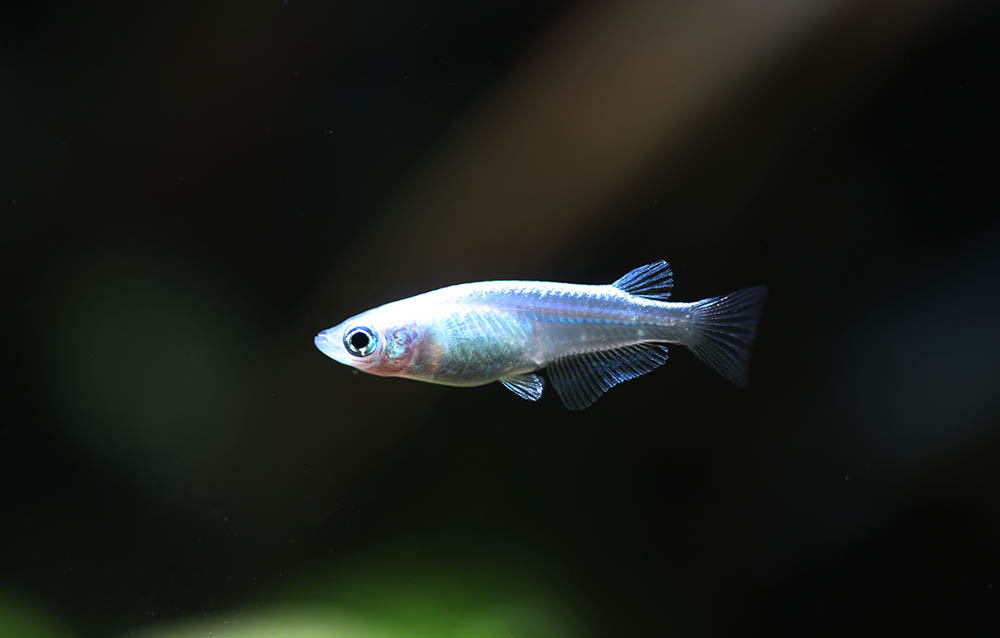
These hardy fish prefer water temperatures from 64–75˚F, but they are reported to survive in water temperatures from the low 40s to over 100˚F. They are peaceful fish that are brightly colored and appropriate for nano tanks. They are shoaling fish, though, so plan to keep a group of them to bring out their social, playful nature. Although typically considered freshwater fish, Japanese Ricefish can survive in brackish and marine water as well.
22. Least Killifish
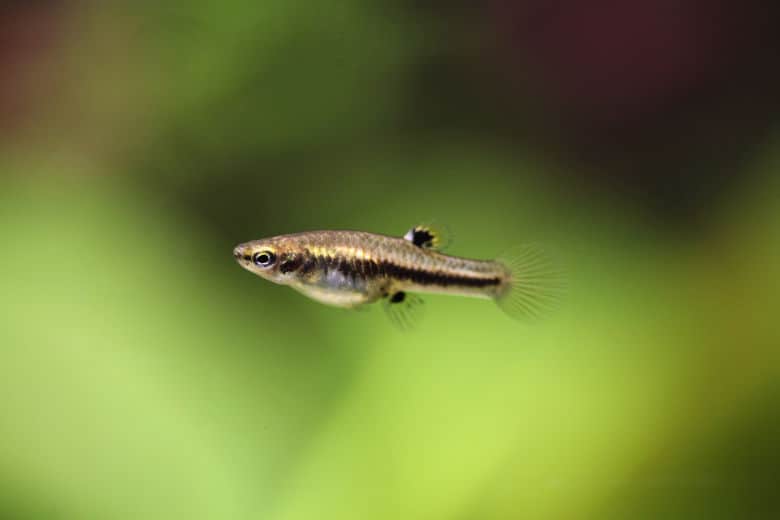
These tiny fish typically don’t even reach 1.5 inches in length, making them one of the smallest livebearers in the world. They are exceptionally hardy fish, able to live in poor water quality and even survive in brackish conditions. They are the perfect nano tank candidate, although they can be difficult to acquire. Least Killifish should be kept in groups with more females than males to prevent aggression, although they are overall peaceful fish. They can be kept in water from 66–75˚F, although they will survive much cooler and warmer temperatures.
23. Clown Killifish

Clown Killifish reaches around the same size as the Least Killifish. They feature black, white, and yellow vertical stripes and are easy to breed. They do best with water temperatures from 68–79˚F. They’re a great option for an unusual nano tank inhabitant, and they are peaceful fish. They are carnivorous fish and prefer live or thawed frozen foods, so be prepared to find tiny foods for them, like copepods and fruit fly larvae.
24. Bristlenose Plecostomus
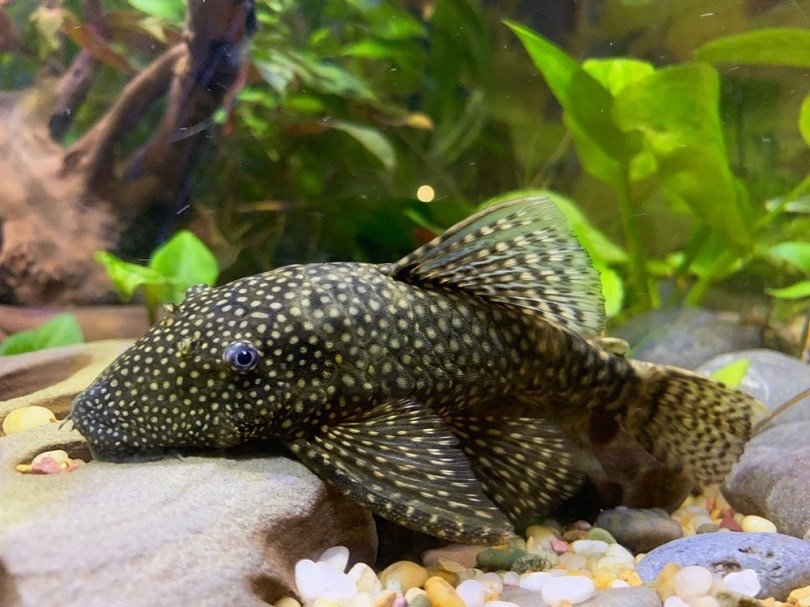
Although most Plecos are tropical, the Bristlenose Pleco can thrive in water between 60–80˚F. They have an unusual set of whiskers on the top of the snout, which is where their name comes from. They need an environment that is well-oxygenated and features driftwood and hiding places. They are one of the better algae-eating options when it comes to Plecos.
25. Rubber Lip Plecostomus
The Rubber Lip Pleco is a hardy Pleco variety, preferring a temperature range between 70–78˚F. In the wild, they live in areas that experience rapid changes in water temperature, level, and quality. They have an almost prehistoric quality about them, making for an interesting addition to your tank. They grow to around 7 inches in length and require a tank that is at least 30 gallons when they are full-grown.
26. Asian Stone Catfish
Potentially the most unusual-looking fish on the list, the Asian Stone Catfish is a little less hardy than many other cold water options. They need good water quality with proper oxygenation. Their tank should be kept between 64–75˚F, although they may be able to tolerate slightly cooler or warmer temperatures. They are tiny, only growing to around 1.4 inches maximum length. They’re timid and peaceful fish that are difficult to breed in captivity. They’re nocturnal fish that need lots of hiding places, especially if there is bright lighting in the tank.
27. Pygmy Sunfish
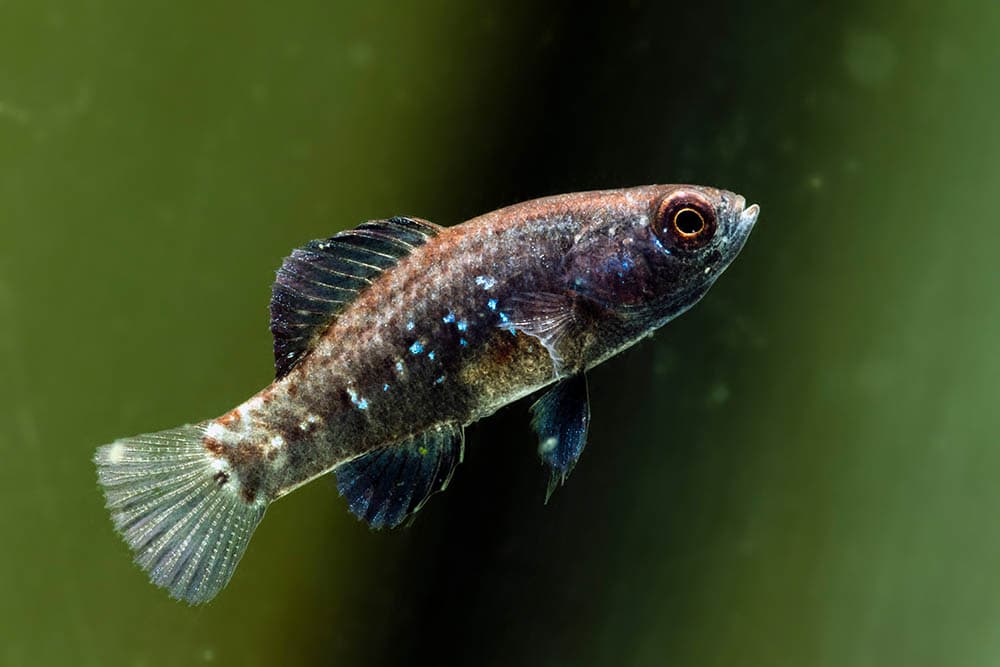
These fish are uncommon in the aquarium trade, so they may be difficult to acquire. The Pygmy Sunfish prefers water temperatures from 50–86˚F, making it ideal for cold water tanks. They are carnivorous fish that prefer live foods, and they are considered moderate care difficulty, so they aren’t the best option for every fish keeper. They prefer well-planted tanks with low water flow, and they can do well in blackwater environments.
28. Paradise Fish
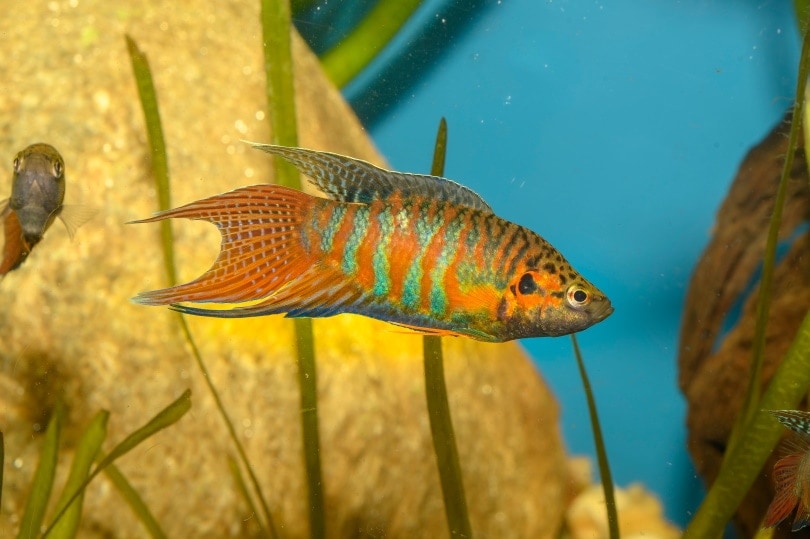
The Paradise fish prefers water temperatures from 61–80˚F. You may also see this fish referred to as a Paradise Gourami or Blue Paradise Gourami. They are semi-aggressive fish that, although easy to care for, aren’t for everyone. Finding tank mates can be difficult because they will fight with other semi-aggressive and aggressive fish, which can injure smaller fish and stress the Paradise fish if the tank mates are larger.
29. Neocaridina Shrimp

Although not fish, Neocaridina shrimp are a great option for cold water and temperate tanks. The most common type of Neocaridina shrimp is the Cherry shrimp, although there are multiple color morphs of these shrimps. They can be kept in water between 57–86˚F. The cooler the water, the slower they will grow and the longer they will live. Warmer water has the opposite effect, resulting in rapid growth and shorter lifespans. These shrimps are easy to breed, although you do need to monitor water hardness and alkalinity to ensure healthy molts.
30. Axolotls
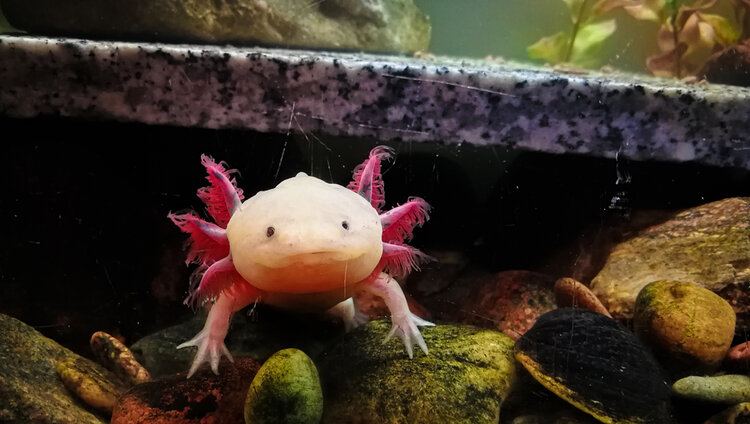
Recently popularized by their appearance in a popular video game, Axolotls, also called Mexican Walking fish, aren’t fish at all. They are a type of salamander that rarely leaves its juvenile life stage, instead staying aquatic throughout its entire life. They are known for their fluffy gills and faces that appear to have permanent smiles. Axolotls cannot adapt long-term to warm water, so they should be kept between 60–70˚F, although 60–64˚F is preferred. They have specific care needs and are not an animal that should be taken home on a whim due to their sensitive nature.
Final Thoughts
A cold water tank doesn’t have to be a boring tank! Tropical fish tend to get all the credit for being interesting and colorful, but there are lots of great cold water options that will bring life and interest to your tank. Whether you’re hoping to keep a community tank or a single fish or two, there are options for your tank. Not having to worry about a heater can make your aquarium care a lot easier, but you do still need to monitor the water temperature, especially if your home gets particularly cool or warm, or if your tank is located near a vent.
Featured Image Credit: boban_nz, Shutterstock


